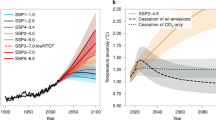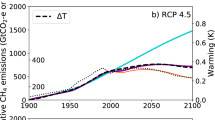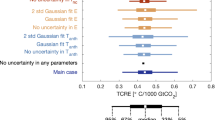Abstract
Climate policies address emissions of many greenhouse gases including carbon dioxide, methane, nitrous oxide and various halogen-containing compounds. These are aggregated and traded on a CO2-equivalent basis using the 100-year global warming potential (GWP100); however, the GWP100 has received scientific and economic criticism as a tool for policy1,2,3,4. In particular, given international agreement to limit global average warming to 2 °C, the GWP100 does not measure temperature and does not clearly signal the need to limit cumulative CO2 emissions5,6,7. Here, we show that future peak temperature is constrained by cumulative emissions of several long-lived gases (including CO2 and N2O) and emission rates of a separate basket of shorter-lived species (including CH4). For each basket we develop an emissions-equivalence metric allowing peak temperature to be estimated directly for any emissions scenario. Today’s emissions of shorter-lived species have a lesser impact on ultimate peak temperature than those nearer the time of peaking. The 2 °C limit could therefore be met by setting a limit to cumulative long-lived CO2-equivalent emissions while setting a maximum future rate for shorter-lived emissions.
This is a preview of subscription content, access via your institution
Access options
Subscribe to this journal
Receive 12 print issues and online access
$209.00 per year
only $17.42 per issue
Buy this article
- Purchase on Springer Link
- Instant access to full article PDF
Prices may be subject to local taxes which are calculated during checkout




Similar content being viewed by others
References
O’Neill, B. C. The jury is still out on global warming potentials. Climatic Change 44, 427–443 (2000).
Shine, K. The global warming potential—the need for an interdisciplinary retrial. Climatic Change 96, 467–472 (2009).
Fuglestvedt, J. S. et al. Transport impacts on atmosphere and climate: Metrics. Atmos. Environ. 44, 4648–4677 (2010).
Gillett, N. P. & Matthews, H. D. Accounting for carbon cycle feedbacks in a comparison of the global warming effects of greenhouse gases. Environ. Res. Lett. 5, 034011 (2010).
Allen, M. R. et al. Warming caused by cumulative carbon emissions towards the trillionth tonne. Nature 458, 1163–1166 (2009).
Matthews, H. D., Gillett, N. P., Stott, P. A. & Zickfeld, K. The proportionality of global warming to cumulative carbon emissions. Nature 459, 829–832 (2009).
Zickfeld, K., Eby, M., Matthews, H. D. & Weaver, A. J. Setting cumulative emissions targets to reduce the risk of dangerous climate change. Proc. Natl Acad. Sci. USA 106, 16129–16134 (2009).
Forster, P. et al. in IPCC Climate Change 2007: The Physical Science Basis (eds Solomon, S. et al.) (Cambridge Univ. Press, 2007).
Lenton, T. 2 °C or not 2 °C? That is the climate question. Nature 473, 7 (2011).
Wigley, T. M. L. The Kyoto Protocol: CO2, CH4 and climate implications. Geophys. Res. Lett. 25, 2285–2288 (1998).
Shine, K., Fuglestvedt, J., Hailemariam, K. & Stuber, N. Alternatives to the global warming potential for comparing climate impacts of emissions of greenhouse gases. Climatic Change 68, 281–302 (2005).
Tanaka, K., O’Neill, B., Rokityanskiy, D., Obersteiner, M. & Tol, R. Evaluating global warming potentials with historical temperature. Climatic Change 96, 443–466 (2009).
Johansson, D. Economics- and physical-based metrics for comparing greenhouse gases. Climatic Change 110, 123–141 (2012).
Fisher, D. A., Hales, C. H., Wang, W-C., Ko, M. K. W. & Sze, N. D. Model calculations of the relative effects of CFCs and their replacements on global warming. Nature 344, 513–516 (1990).
Manne, A. S. & Richels, R. G. An alternative approach to establishing trade-offs among greenhouse gases. Nature 410, 675–677 (2001).
Kandlikar, M. Indices for comparing greenhouse gas emissions: Integrating science and economics. Energ. Econ. 18, 265–281 (1996).
Eckaus, R. S. Comparing the effects of greenhouse gas emissions on global warming. Energy J. 13, 25–36 (1992).
Plattner, G-K., Stocker, T., Midgley, P. & Tignor, M. IPCC Expert Meeting on the Science of Alternative Metrics (IPCC, 2009).
Oppenheimer, M. & Petsonk, A. Article 2 of the UNFCCC: Historical origins, recent interpretations. Climatic Change 73, 195–226 (2005).
Shine, K. P., Berntsen, T. K., Fuglestvedt, J. S., Skeie, R. B. & Stuber, N. Comparing the climate effect of emissions of short- and long-lived climate agents. Phil. Tran. R. Soc. A 365, 1903–1914 (2007).
Matthews, H. D. & Caldeira, K. Stabilizing climate requires near-zero emissions. Geophys. Res. Lett. 35, L04705 (2008).
Van Vuuren, D. P., Weyant, J. & De la Chesnaye, F. Multi-gas scenarios to stabilize radiative forcing. Energ. Econ. 28, 102–120 (2006).
Cox, P. M. & Jeffery, H. A. Methane radiative forcing controls the allowable CO2 emissions for climate stabilization. Curr. Opin. Environ. Sustain. 2, 404–408 (2010).
Jackson, S. C. Parallel pursuit of near-term and long-term climate mitigation. Science 326, 526–527 (2009).
Daniel, J. et al. Limitations of single-basket trading: Lessons from the Montreal Protocol for climate policy. Climatic Change 111, 241–248 (2012).
Wigley, T. M. L. & Raper, S. C. B. Interpretation of high projections for global-mean warming. Science 293, 451–454 (2001).
Andrews, D. G. & Allen, M. R. Diagnosis of climate models in terms of transient climate response and feedback response time. Atmos. Sci. Lett. 9, 7–12 (2008).
Meinshausen, M. et al. The RCP greenhouse gas concentrations and their extensions from 1765 to 2300. Climatic Change 109, 213–241 (2011).
Meehl, G. A. et al. in IPCC Climate Change 2007: The Physical Science Basis (eds Solomon, S. et al.) (Cambridge Univ. Press, 2007).
Shindell, D. et al. Simultaneously mitigating near-term climate change and improving human health and food security. Science 335, 183–189 (2012).
Acknowledgements
We thank K. Shine and D. Shindell for discussions during the progress of this research. We are grateful to T. Wigley and the other model developers for making MAGICC freely available. S.M.S. was supported by the UK Committee on Climate Change (the views expressed herein represent those of the authors and do not necessarily represent the views of the committee). J.A.L. and L.K.G. were supported by the joint Department of Energy and Climate Change/Department for Environment, Food and Rural Affairs Met Office Hadley Centre Climate Programme (GA01101). N.H.A.B. was supported by a Natural Environment Research Council CASE studentship with the Met Office. M.R.A. received additional support from the US National Oceanic and Atmospheric Administration and the US Department of Energy through the International Detection and Attribution Group. C.H. was supported by the Centre for Ecology & Hydrology science budget fund.
Author information
Authors and Affiliations
Contributions
S.M.S. designed the research with input from J.A.L. Decadal emissions plots were devised by N.A.H.B., C.H. and M.R.A. S.M.S. carried out all simulations with advice on model setup from L.K.G. All authors contributed to writing the paper.
Corresponding author
Ethics declarations
Competing interests
The authors declare no competing financial interests.
Supplementary information
Rights and permissions
About this article
Cite this article
Smith, S., Lowe, J., Bowerman, N. et al. Equivalence of greenhouse-gas emissions for peak temperature limits. Nature Clim Change 2, 535–538 (2012). https://doi.org/10.1038/nclimate1496
Received:
Accepted:
Published:
Issue Date:
DOI: https://doi.org/10.1038/nclimate1496
This article is cited by
-
National contributions to climate change due to historical emissions of carbon dioxide, methane, and nitrous oxide since 1850
Scientific Data (2023)
-
Definitions and implications of climate-neutral aviation
Nature Climate Change (2022)
-
Consequences of equivalency metric design for energy transitions and climate change
Climatic Change (2022)
-
Indicate separate contributions of long-lived and short-lived greenhouse gases in emission targets
npj Climate and Atmospheric Science (2022)
-
Global and regional drivers of land-use emissions in 1961–2017
Nature (2021)



